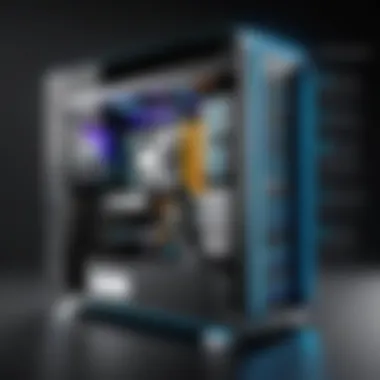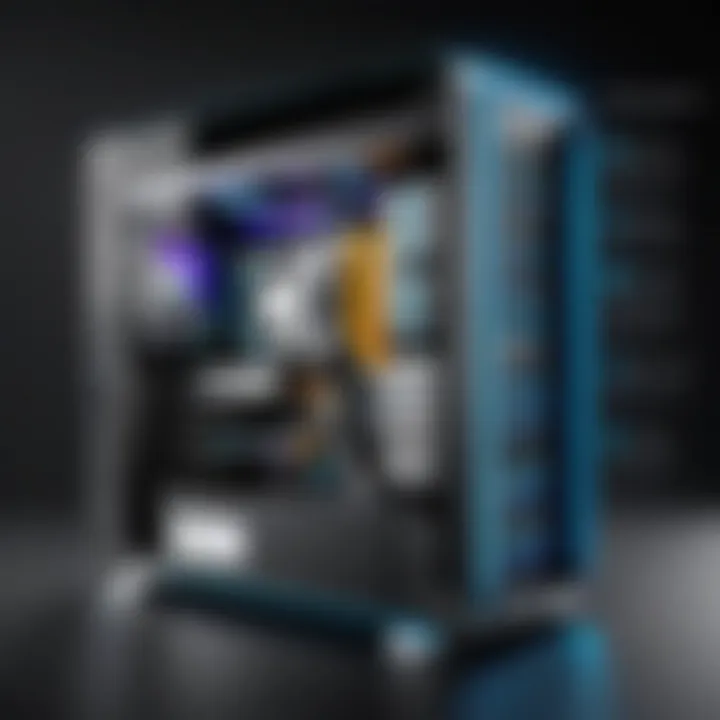Mastering Partition Magic on Windows 10: A Comprehensive Guide


Intro
In any Windows 10 system, the management of disk space is crucial for both performance and organization. This is where partitioning tools like Partition Magic play a significant role. Understanding how to effectively use such tools allows users to maintain their systems better, optimize storage, and enhance the overall computing experience.
Partition Magic is a specialized software that enables users to create, resize, and delete partitions on hard drives with ease. This article explores various aspects of Partition Magic, focusing on its functionalities, installation procedure, and practical applications. In this way, readers can make informed decisions regarding the management of their disk space.
Overview of the Technology
Partition Magic has evolved through various updates to effectively manage disk partitions on Windows 10. This section outlines its key specifications and unique selling points that make it a useful tool for users.
Key Specifications
- Compatibility: Works seamlessly with Windows 10 and earlier versions.
- Partition Types: Supports various file systems, including NTFS, FAT32, and more.
- Features: Offers resizing, merging, and copying features for partitions.
- User Interface: Intuitive design that accommodates technical and non-technical users.
Unique Selling Points
- Efficiency: Reduces the time taken to manage partitions, thanks to its quick operations.
- Data Safety: Minimizes the risk of data loss during partitioning processes through backup functionalities.
- Versatility: Suitable for both home users and advanced IT professionals.
"Partition Magic allows users to harness the full potential of their disk space efficiently and securely."
This overview sets the stage for a deeper dive into Partition Magic, focusing on its installation, benefits, and potential drawbacks.
Understanding Partition Magic
Understanding Partition Magic is essential for users who want to effectively manage their hard drives and optimize system performance. Disk management is a critical aspect of computing, ensuring that resources are allocated efficiently. With the ability to divide a hard disk into multiple partitions, users can organize their data, separate operating systems, and control how storage is utilized.
Partition Magic, specifically, offers a suite of features designed to simplify these tasks. For example, it allows users to resize partitions without losing data and provides tools for managing file systems. This functionality can lead to more organized data storage and improved system efficiency.
However, users should also be aware of certain considerations when using Partition Magic. For instance, while partitioning can enhance performance, improper management can lead to data loss or system instability. Thus, a clear understanding of Partition Magic not only equips users with the knowledge to enhance their computing experience but also helps mitigate risks associated with disk management.
What is Partition Magic?
Partition Magic is a software application developed to perform partitioning tasks on hard drives. It was created to enable users to manage disk partitions effectively. With this tool, one can create, resize, and delete partitions without the need to reformat the entire drive. Using such software can save significant time and effort in managing disk space.
The core functions of Partition Magic include:
- Creating new partitions for organizing data
- Resizing existing partitions to better utilize disk space
- Deleting partitions that are no longer needed
- Offering backup and recovery features to protect data during the partitioning process
This software supports various file systems, enabling it to work seamlessly with different operating systems, which makes it a versatile solution for diverse users.
History of Partition Magic Software
Partition Magic was first introduced in the late 1990s. Initially, its primary goal was to simplify the complicated and risky process of disk partitioning. Over the years, it gained popularity, especially among users who needed to manage multiple operating systems on a single machine. Its user-friendly interface was one of the key factors in its widespread adoption.
As technology evolved, Partition Magic saw a series of updates to keep up with expanding hardware and software requirements. Notably, it provided support for modern file systems like NTFS and exFAT, which improved its relevance in an increasingly digital world.
Unfortunately, in 2011, Symantec, the company that acquired Partition Magic, discontinued the software due to shifts in the market and advancements in Windows disk management tools. However, by that time, it had already established itself as a significant tool in the realm of disk partition management. Users still refer back to its functionalities, highlighting the need for effective partition management in various computing environments.
Features of Partition Magic for Windows
Partition Magic for Windows 10 comes with a range of features designed to enhance user experience and ensure efficient disk management. Understanding its functionalities provides insight into how it can optimize the performance of your system. In this section, we will delve into essential features that make Partition Magic valuable for both novice and experienced users, including disk partition management, file system support, and boot management tools.
Disk Partition Management
One primary functionality of Partition Magic is its disk partition management capability. This feature allows users to create, resize, and delete partitions without losing data. Effective disk partitioning helps allocate disk space strategically, which can improve overall system speed. With the proper allocation, users can enhance performance for applications that require more space. When using Partition Magic, users can quickly assess their current partition structures and make adjustments as needed, whether for personal files or critical software installations.
The importance of disk partition management should not be underestimated. It results in a more organized file system. Proper partitioning can help isolate system files from personal data, which simplifies backup processes and increases data security. Users can also mount partitions in different locations, providing flexibility in accessing files.
File System Support
Partition Magic offers an extensive array of file system support. This aspect is critical because it allows users to manage their partitions regardless of the file system format. It supports commonly used systems such as NTFS, FAT32, and exFAT. The versatility ensures that users can utilize the software across different devices and operating systems.
Furthermore, being able to switch file systems is beneficial when users need to extend the life of older hardware or adapt to new technologies. For instance, converting from FAT32 to NTFS can provide benefits like greater file size limits and enhanced security features. The software simplifies these transitions, making it accessible for users who might not be as tech-savvy. The ability to switch file systems contributes greatly to optimizing storage performance.
Boot Management Tools
Another significant feature of Partition Magic is its boot management tools. These tools provide users the capability to manage multiple operating systems on a single machine, which is especially useful for advanced users who run different software environments. This feature allows you to configure boot priority settings and create bootable media easily.
The boot management interface in Partition Magic can simplify the process of dual-booting or troubleshooting boot errors. For a tech-savvy audience, having this control means users can switch between operating systems without needing external boot loaders or complicated configurations. Well-implemented boot management directly correlates to a more efficient workflow, minimizing downtime when switching tasks.
Efficient disk partitioning not only promotes better performance, but it can also manage multiple operating systems effectively, catering to the needs of diverse computing environments.
In summary, the features of Partition Magic for Windows 10 equip users with powerful tools for managing their storage effectively. The emphasis on disk partition management, extensive file system support, and streamlined boot management tools fosters an environment conducive to optimal system operation. These functionalities collectively empower users to take full advantage of their hardware capabilities.
Installation Process on Windows


The installation process of Partition Magic on Windows 10 is a critical component of successful disk management. A well-executed installation safeguards users from potential issues that might arise during partitioning tasks. Understanding the procedure not only ensures the application operates efficiently but also helps to maximize the benefits of features built into the software.
Successful installation enables users to manage their hard drives with precision. This process allows for seamless execution of tasks such as partition resizing, merging, and data recovery. A thorough comprehension of the installation elements, system requirements, and potential stumbling blocks can streamline the entire operation. By effectively preparing for installation, users can minimize troubles and enhance functionality from the outset.
System Requirements
Before installing Partition Magic, it is essential to check the system requirements to ensure compatibility. Here are some notable aspects:
- Operating System Compatibility: The software must be compatible with Windows 10.
- Processor: A 1 GHz or faster processor is generally advised.
- RAM: Minimum of 1 GB is recommended for 32-bit and at least 2 GB for 64-bit systems.
- Hard Disk Space: Ensure there is at least 200 MB of free space for the installation process.
- Additional Requirements: A display resolution of 800 x 600 pixels or higher could also be a factor for optimal user experience.
Verifying these requirements before proceeding can save time and prevent frustrations.
Step-by-Step Installation Guide
Engaging with the installation process can be straightforward if you follow a structured method. Here’s a concise step-by-step guide:
- Download the Installation File: Visit the official website of Partition Magic to download the installer.
- Run the Installer: Once downloaded, locate the installation file in your downloads folder and double-click to run it.
- User Account Control: If prompted, allow the installer to make changes to your device.
- Follow the On-Screen Instructions: The installation wizard will guide you through necessary steps. Select your preferred settings.
- Complete the Installation: Once the wizard suggests that the installation is complete, click on the finish button.
- Restart Your Computer: To finalize the setup, restarting your PC often helps integrate the software into the system effectively.
Following these steps can take you from downloading to fully operating Partition Magic quickly.
Common Installation Issues
Despite its generally smooth installation, users may encounter several common issues. Awareness of them can greatly assist in troubleshooting:
- Insufficient Disk Space: This is a prevalent issue, often leading to installation failure. Ensure enough free space is available on your hard disk.
- Compatibility Problems: Make sure version of Partition Magic is intended for Windows 10.
- Corrupted Installer Files: Sometimes, the downloaded installer may be corrupt due to an interrupted download. Redownloading can resolve this.
- User Permissions: Lack of proper administrative rights can prevent successful installation. It may be necessary to run the installer as an administrator.
Addressing these potential stumbling blocks before they escalate can ensure a seamless installation experience.
Ensuring compatibility and meeting system requirements are the first steps toward a successful installation of Partition Magic on Windows 10.
Basic Operations of Partition Magic
Understanding the basic operations of Partition Magic is essential for maximizing the utility of this powerful disk management tool on Windows 10. Properly managing partitions can enhance system performance, optimize storage usage, and provide better organization of data. With a well-structured partition scheme, users can ensure that their operating system runs smoothly while also isolating files for easier access and security. This section delves into the primary operations of creating, resizing, and safely deleting partitions, essential activities that require careful consideration and execution.
Creating a New Partition
Creating a new partition is a fundamental task that allows you to allocate a specific portion of your hard drive for particular uses. This can be useful for various reasons, such as dedicating space for operating systems, applications, or data storage. The process is straightforward but requires attention to detail. To create a new partition:
- Open Partition Magic and select the unallocated space on your hard drive.
- Right-click and choose the option to create a new partition.
- You will be prompted to select attributes such as size, file system, and partition label.
- Confirm the changes before applying.
Having separate partitions means that you can manage your files efficiently without the risk of encountering performance bottlenecks that arise from a cluttered primary drive.
Resizing Partitions
Resizing partitions is a key feature of Partition Magic. This capability allows users to adjust the size of existing partitions based on their evolving storage needs. For instance, if a specific partition is running low on space, you can allocate additional space from an underutilized partition. Here’s how to resize a partition:
- Select the partition you want to resize in the main interface.
- Use the resize option and drag the handles to set the desired size.
- Ensure that the changes do not interfere with adjacent partitions.
- Apply the changes to commit the new size configurations.
Resizing partitions helps maintain system efficiency and functionality, allowing you to optimize your storage dynamically.
Deleting Partitions Safely
Deleting partitions can be a risky operation if not performed correctly. It is crucial to ensure that any data on the partition is backed up before proceeding with deletion. When a partition is deleted, all data contained within it is lost. To delete partitions safely:
- Make sure to back up any important data. Use external drives or cloud storage for backups.
- Select the partition you wish to delete within Partition Magic.
- Right-click and choose the delete option.
- Confirm the deletion prompt to finalize the action.
Deleting unnecessary partitions frees up storage space, but it’s imperative to proceed with caution. Data recovery after deletion can be complex, which is why a solid backup strategy is important.
In summary, mastering these basic operations within Partition Magic not only allows users to tailor their storage solutions according to their needs but also plays a crucial role in maintaining data organization and system performance.
Advanced Features and Functions
Advanced features within Partition Magic elevate its utility beyond basic partitioning tasks. These functions allow users to manage disk space, optimize performance, and recover lost data. Understanding these capabilities is important for effective disk management, especially for more sophisticated users who might need intricate solutions to their data organization and system efficiency problems.
Merging Partitions
Merging partitions is a key feature when one needs to reclaim unusable disk space or consolidate data into fewer partitions. This process removes one partition and integrates its space into another. For instance, if your hard drive has multiple partitions that are underused, merging them can help simplify file management.
Benefits of Merging Partitions:
- Improved Performance: Fewer partitions can lead to better disk performance since the file system has to manage less metadata.
- Easier Organization: Users can navigate their files more seamlessly when they are consolidated into a single or fewer partitions.
- Recovery of Space: Unused partitions can consume space that could otherwise be utilized.
Considerations: Merging partitions involves a few points to consider. Always back up the data before proceeding to avoid losing important files. Furthermore, some operating systems might require a reboot to finalize the merging process.
Converting File Systems


Converting file systems is another essential function within Partition Magic. Different operating systems and devices prefer different file systems such as NTFS, FAT32, and exFAT. Each file system has its own strengths and weaknesses. For example, NTFS supports larger files and better security features, while FAT32 is compatible with a wider array of devices.
Key Aspects of File System Conversion:
- Compatibility: Converting can enhance compatibility with other systems. For instance, if data needs to be transferred between devices, using a common file system is beneficial.
- Performance Optimization: The right file system can improve access times and overall performance of the storage device.
- Security: More advanced file systems offer encryption options, helping protect sensitive data.
Points to Remember: While converting file systems, users should back up their data. The conversion process can lead to data corruption if not executed carefully, so make this a priority.
Recovering Lost Partitions
Recovering lost partitions addresses a critical issue faced by users. Partitions can disappear due to various reasons such as accidental deletion, formatting errors, or damaged disk. The ability to retrieve these lost partitions is vital and can save significant amounts of time and effort.
Advantages of Recovery Features:
- Data Preservation: Recovering a lost partition allows users to retain access to files that might otherwise be permanently lost.
- Time Efficiency: Instead of starting over, the recovery feature can expedite regaining access to the lost data.
Best Practices for Recovery: Always try to minimize the use of the affected disk, as writing new data can overwrite information, making recovery more challenging. The software typically provides wizards and step-by-step instructions to facilitate this process smoothly.
"Data recovery can often be a repair game. Acting fast gives you the best chance without losing your precious files."
Comparing Partition Magic Alternatives
In the realm of disk management, having options is essential. While Partition Magic offers robust capabilities, several alternatives exist that cater to varying user needs and preferences. By comparing Partition Magic alternatives, users can make informed decisions based on specific features, benefits, and usability. This section will delve into three notable alternatives: GParted, EaseUS Partition Master, and AOMEI Partition Assistant. Each has distinct strengths and considerations that could serve different user requirements.
GParted Overview
GParted is a free, open-source partition editor for Linux, but it can also be run on Windows via a live USB or DVD. Its primary strength lies in its ability to handle complex partitioning tasks without the need for installation. Here are some key features of GParted:
- Free of Charge: Unlike some commercial alternatives, GParted is completely free.
- System Compatibility: It supports a variety of file systems, making it versatile for users managing multiple operating systems.
- Live Environment: Users can make changes without booting into their installed operating systems, providing a safe working environment.
However, GParted may not be as user-friendly for those not familiar with Linux environments. It lacks a native Windows interface and requires some technical knowledge to navigate.
EaseUS Partition Master Features
EaseUS Partition Master is a popular choice among Windows users for its simple interface and robust feature set. Its advantages include:
- User-Friendly Interface: The software presents a clear and easy to navigate layout, making it accessible for beginners.
- Comprehensive Features: Users can create, resize, merge, and split partitions with just a few clicks.
- Data Recovery Tools: EaseUS offers recovery options for those who might accidentally delete partitions.
- Live Update Capability: This ensures that users have access to the latest features and improvements.
Despite these benefits, the free version has limitations regarding the maximum size for operations, which may require users to upgrade to the paid version for larger tasks.
AOMEI Partition Assistant Review
AOMEI Partition Assistant stands out for its advanced features and flexibility. Some notable points include:
- Multi-Operating System Support: It supports many Windows versions and offers compatibility with various file systems.
- Partition Recovery Wizard: This tool helps retrieve lost partitions with straightforward steps.
- Migrate OS Feature: Users can easily clone their operating system to a new disk, facilitating upgrades without losing data.
- Partition Alignment: It optimizes partition performance, which can enhance speed.
While AOMEI Partition Assistant offers a rich feature set, some users may find the interface slightly overwhelming at first. However, once understood, it provides powerful tools that can significantly aid in maintaining disk structure and performance.
"Selecting the right partition management tool can streamline disk handling and enhance your system's performance."
Troubleshooting Common Issues
In any software application, especially those handling critical system functions like partitioning, challenges can arise. Troubleshooting common issues related to Partition Magic is essential for maintaining a smooth user experience. Here, we focus on understanding potential difficulties and their resolutions. Efficient troubleshooting not only saves time but also prevents data loss or system instability. Recognizing these common problems allows a more educated approach to disk management, fostering better usage of the software's capabilities.
Partition Errors and Recovery
Partition errors can occur for several reasons, such as unexpected system crashes, improper resizing, or conflicting software actions. These errors may lead to data loss, unrecognized partitions, or inaccessible drives. Therefore, being aware of how to identify and correct these errors is crucial.
- Identifying Partition Errors: Common indicators include system warnings during startup or software prompts indicating a problem with disk partitions. Checking in the Disk Management tool in Windows can provide a clear view of current partitions and their health.
- Recovery Options: Depending on the severity of the error, options for recovery include:
- Using Built-in Recovery Tools: Windows’ built-in recovery environment can help repair basic partition issues.
- Third-party Tools: Applications such as EaseUS Partition Recovery or MiniTool Partition Wizard may provide advanced options for recovering lost partitions.
- Data Recovery Software: In severe cases of data loss, specialized recovery tools might be required to retrieve lost files from damaged partitions.
Always ensure that you back up important data before attempting any recovery process; recovering data can sometimes lead to further complications.
Performance Issues During Partitioning
Performance issues during partitioning can manifest as slow operation times, freezes, or unexpected reboots. These challenges can be frustrating and impact user efficiency. Consequently, it is vital to identify their root causes and apply suitable solutions.
- System Requirements: Insufficient system resources, such as RAM or CPU power, can lead to performance degradation. Verify your system's specifications against Partition Magic's requirements to ensure compatibility.
- Disk Fragmentation: Over time, fragmentation can slow down disk operations. Running a disk defragmentation tool can improve performance before initiating partition changes.
- Background Processes: Close unnecessary applications during partitioning. High CPU usage from other programs can lead to a lag in partitioning tools. It is advisable to check the Task Manager for any resource-intensive tasks running in the background.
- Disk Health: Regularly running health checks on your hard drives can preempt issues. Diagnostic tools can reveal underlying problems that may affect performance.
By following these guidelines of troubleshooting partition errors and performance issues, users can maintain the stability and efficiency of their system's disk management tools. Further understanding allows better control of how Partition Magic can be employed effectively.
Security Considerations
Understanding security considerations when using disk partitioning software, like Partition Magic, is essential for ensuring both data integrity and privacy. Mismanagement of partitions can lead to data loss, corruption, or unauthorized access to sensitive information. Therefore, implementing robust safety measures is not merely advisable; it is vital. Working with partitions requires comprehensive knowledge about the potential risks associated with data manipulation and storage.


Data Backup Before Partitioning
Before making changes to your disk's structure, executing a complete data backup is crucial. Ignoring this step can potentially result in irreversible data loss. Consider the following steps for effective data backup:
- Choose a Reliable Backup Solution: You can use solutions such as Windows Backup, Acronis True Image, or Macrium Reflect. These tools allow for full disk imaging, ensuring data is safely stored elsewhere.
- Identify Critical Files: Create a list of files and folders crucial for your work or personal use. This can speed up the backup process.
- Verify Backup Integrity: Once the backup is completed, ensure that it works by testing recovery of a file or a folder. This step reduces the risk of relying on a corrupted backup.
This preemptive action minimizes disruptions caused by unexpected errors during the partitioning process.
Protecting Partitioned Data
After creating partitions, safeguarding data within these partitions becomes essential. Effective data protection can be implemented through the following strategies:
- Encryption: Utilize built-in encryption tools such as BitLocker for Windows-based systems. This adds an additional layer of security by making data unreadable without the proper decryption key.
- Access Control: Set access permissions on the partitions to restrict unauthorized users from accessing sensitive data. This can be managed through the file properties settings in Windows.
- Regular Updates: Keeping your software updated ensures that security patches are applied, reducing vulnerabilities that could be exploited by malware or viruses.
Protecting your data is a continuous process, not a one-time task. Regularly assess and update your security protocols.
Adhering to these practices not only secures your data but also provides peace of mind as you navigate through disk partitioning tasks. Effective management of these considerations contributes to a safer computing environment.
User Experience and Interface Analysis
User experience and interface are significant aspects in utilizing Partition Magic on Windows 10 effectively. A well-designed interface can simplify complex tasks, making it easier for users to perform disk management functions. The importance of this topic becomes evident when considering how users interact with the software and the efficiency of their workflow.
Navigating the User Interface
Navigating the user interface of Partition Magic is crucial for achieving desired results without unnecessary delays. The layout should be intuitive, allowing users to access features like partition creation, resizing, or deletion effortlessly. Key elements that facilitate navigation include clearly labeled buttons, logical progression of tasks, and accessible help documentation. Users often find it beneficial to explore the main dashboard first, as it typically displays the status of existing partitions along with available actions.
Here are several tips on using the interface effectively:
- Familiarize with the dashboard overview: This provides a helpful glance at the health and status of all disks.
- Use drag-and-drop functionalities: Resizing partitions can often be accomplished with simple mouse movements.
- Explore shortcut keys: Many interfaces support keyboard shortcuts that speed up operations.
A clear, user-friendly interface reduces the learning curve, making the software accessible even to less experienced users. A seamless navigation experience translates into effective utilization of Partition Magic's features.
User Feedback and Reviews
User feedback offers invaluable insight into the performance and usability of Partition Magic. Reviews from tech-savvy individuals frequently highlight what aspects of the software are beneficial and which could be improved. Common points include positive remarks on the functionality the software provides, while critiques often address occasional bugs or user interface difficulties.
Feedback can be sourced from platforms such as Reddit and tech forums. Users review their experiences, often emphasizing:
- Functionality: Many appreciate how well Partition Magic handles complex operations, such as multi-partition resizing without data loss.
- Documentation: Users often comment on the clarity of available online resources and manuals, which aid in understanding the software’s capabilities.
- Customer Support: Satisfaction with response time and helpfulness of support teams can vary widely.
"A thorough user experience is essential for maintaining productivity while managing disk space effectively."
In evaluating Partition Magic, the sentiments of the user community serve as a guide for potential users considering its adoption. Taking time to absorb these reviews can greatly influence one’s choice in partition management tools.
Impact on System Performance
In the context of computer systems, disk partitioning plays a crucial role in optimizing performance. Partition Magic serves as a valuable tool to effectively manage your hard drive and its resources. Understanding the impact of partitioning can help you make informed choices regarding your computer's speed, organization, and overall user experience. Properly configured partitions can enhance system responsiveness and help mitigate risks associated with data loss.
How Partitioning Affects Speed
One of the most significant benefits of partitioning is its potential to improve system speed. When a drive is split into various partitions, the operating system can access files more efficiently.
- Faster Access Time: With less data to sift through on a single partition, the read/write head has less distance to travel. This can drastically reduce the time it takes to access files.
- Defragmentation Benefits: Smaller partitions are easier to defragment. A well-defragmented partition can significantly enhance performance, as data is stored more contiguously.
- System Boot Times: Dedicated partitions for the operating system can enhance boot times. When system files are on a separate partition, the operating system can load more efficiently.
"Partitioning your hard drive can lead to better organization and improved load times as the system only needs to look for data within a designated area."
Balancing Storage Across Partitions
An additional consideration in maximizing performance is ensuring a balanced allocation of storage across your partitions.
- Avoiding Overcrowding: An overcrowded partition can lead to slower access speeds. Each partition should maintain enough free space to allow for regular use and future growth.
- Adjusting Space Allocation: If one partition holds too much data while another remains underutilized, it might be worthwhile to resize them accordingly. Partition Magic allows users to easily adjust sizes to better suit their needs.
- Data Organization: Logical storage organization can lead to faster searches and easier file management. Keeping related files within the same partition reduces confusion and can speed up data retrieval.
In summary, understanding the impact of system performance linked to partitioning is about more than just improving speed. It is about creating a responsive and well-organized system that ultimately enhances the user's experience. Taking care to balance storage across partitions can lead to an efficient, long-lasting solution to your disk management needs.
Culmination and Recommendations
In concluding the exploration of Partition Magic on Windows 10, it becomes evident that understanding partitioning is crucial for maximizing system performance and safeguarding data integrity. This section emphasizes the significant benefits, key considerations, and recommendations to make the most out of your partition management efforts.
With effective partitioning, users can enhance system speed and ensure optimal storage allocation. Partition Magic provides tools that facilitate the organization of disk spaces, allowing better management of files and applications. Moreover, it can help improve boot times and overall system efficiency. These enhancements are critical, especially for users who deal with heavy workloads or extensive media libraries.
On the other hand, one must approach partitioning with caution. Risks such as data loss or corruption can occur without proper backups and understanding. Therefore, it is advisable to always conduct a full backup before modifying partitions. This preserves data and mitigates potential issues that may arise from unintended actions.
In summary, utilizing Partition Magic on Windows 10 can symbolically reshape the way users interact with their systems. Still, informed decisions and proactive data management strategies should guide these actions.
Key Takeaways
- Optimization Potential: Effective disk partitioning can significantly improve performance by allocating resources smartly across your system.
- Data Safety: Always prioritize data backup before any partition adjustments to avoid potential losses and ensure you have recovery options.
- Cautious Approach: Understanding your specific needs is necessary before embarking on partitioning tasks. It can prevent complications and streamline usage.
- Explore Alternatives: While Partition Magic is powerful, consider also evaluating alternatives like GParted or EaseUS Partition Master, which may cater better to specific needs.
Final Thoughts on Partition Magic
Partition Magic remains a relevant tool for users navigating Windows 10 environments. The ability to customize disk spaces and manage partitions gives users greater control over their systems. However, it is also vital to remain cognizant of the inherent risks associated with partition management.
As technology evolves, so too does the landscape of partition management solutions. Keep learning and researching to adapt to new tools and methods. The insights gathered from this guide should empower you to harness the full capabilities of Partition Magic or any suitable alternatives. Stay proactive in managing your partitions to maintain a healthy, efficient digital workspace.







